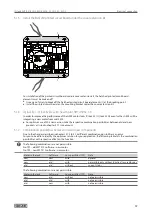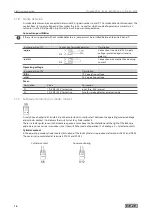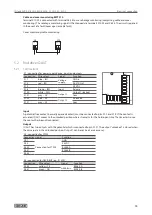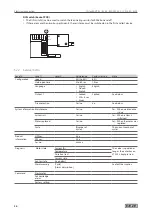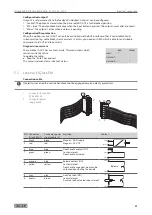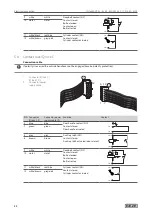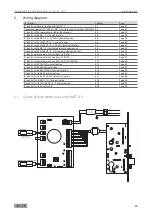
IQ lock AUT, EL / EL DL, EM / EM DL, C / C DL, M / M DL
8
Functions and properties
3.2 Explanation of terms, functions and properties
Panic function
The lock can be unlocked at any time by pressing the door handle/panic bar in the direction of emergency exit.
Sliding fitting systems
According to DIN EN 179 or 1125 the sliding fitting systems must be tested together with the lock. A list of tested
sliding fitting systems can be found in the certificates for consistency of performance (see chapter 9).
Mechanical re-locking
The two cross latches are
latched by actuating the auxiliary latch.
Latching of the two cross latches only takes place after this has engaged and positioned itself in the strike plate.
Crossbar projection only takes place after the cross latch
has been positioned in the strike plate.
Electrical time-out function
During release time,
manipulation attempts on the auxiliary latch by the control are ignored and the crossbar
remains retracted.
After the set release time has expired, the crossbar is extended when the auxiliary latch is activated. The control
detects the manipulation
attempt by the check on the door position and the motor retracts the crossbar again.
Secured by day with electric strike function
In adjustable daytime operation, the crossbar remains retracted even if the door has closed and the two cross
latches are in place.
The door cannot be passed from the outside, from the inside escape is possible at all times through the panic
function.
In connection with access control, for example, shortest possible opening times well under one second are now
achieved, which has only been possible with electric strikes before.
Exception: In the event of a fire the door is completely locked. The motor lock is actuated directly by the fire
alarm system in this case (see chapter 1.7).
Permanent unlocked
Alongside automatic re-locking (“night” mode of operation) and secured daytime operation (“secured by day”
mode of operation), the third mode of operation “permanently unlocked” is possible (see Setting permanently
unlocked, chapter 5.1).
Here, the crossbar is retracted and the cross latches are unstable. The door can be pulled or pushed open at any
time by hand.
Exception: In the event of a fire the door is locked completely after the door leaf has closed.
The motor lock is actuated directly by the fire alarm system in this case.
Outside handle, electrically engaged
When the supply voltage is applied to the lock, the outside handle is engaged and remains engaged as long as
current is flowing (working current principle).
As soon as the voltage supply stops, the outside handle is disabled and the door can no longer be opened using
the handle. The panic function is retained.
Thanks to the nightlatch function integrated in all our locks, the lock can be opened using the matching key (e.g.
by the fire brigade).
Automatic locking mechanism in the event of a power failure
In the event of a power failure, the motor is actuated via the capacitor integrated in the control in such a way that
the slide bolt in the lock can move to the “night” position. This automatically pre-closes the crossbar when the
door is closed.
If the door is still open at this point, the crossbar projection is controlled via the auxiliary latch when the door is closed.
Input for fire alarm system
The automatic locking mechanism of the motor lock in the event of a fire is activated via the input for the fire
alarm system on the motor lock control.
This takes place automatically no matter which mode of operation is selected (night mode, secured by day or
permanently unlocked).
Feedback contacts for lock states
The number and type of signals as well as the maximum load of the switching contacts can be found in chapters
Sabotage monitoring
The connection cable is monitored to check for interruptions in the cable. In addition, the cover of the motor lock
control can be integrated in the monitoring process by means of a cover lift-off contact.
Summary of Contents for IQ lock AUT
Page 56: ...IQ lock AUT EL EL DL EM EM DL C C DL M M DL 56 Wiring diagrams ...
Page 66: ...IQ lock AUT EL EL DL EM EM DL C C DL M M DL 66 Annex ...
Page 68: ...IQ lock AUT EL EL DL EM EM DL C C DL M M DL 68 Annex ...
Page 70: ...IQ lock AUT EL EL DL EM EM DL C C DL M M DL 70 Annex ...
Page 71: ...IQ lock AUT EL EL DL EM EM DL C C DL M M DL 71 Annex ...

















